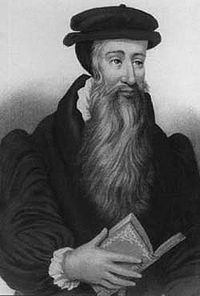- John Knox
-
John Knox (1514-1572) fue un sacerdote escocés, líder de la Reforma Protestante en Escocia, y es considerado el fundador de presbiterianismo. Influenciado por los primeros reformadores como George Wishart, se unió al movimiento reformista de la Iglesia escocesa. Estuvo envuelto en los eventos eclesiásticos y políticos relacionados con la muerte del Cardenal Beaton en 1546 y en la intervención de la regente de Escocia, María de Guisa. Fue hecho prisionero por las fuerzas francesas al año siguiente, y tras su puesta en libertad en 1549 se exilió a Inglaterra. Es reconocido como el Padre de la Reforma en Escocia.
Biografía
Nació cerca de Haddington (Escocia) en 1514 y se formó en la universidad de San Andrés. Discípulo de G. Wishart (1513-1546), asesinado en la hoguera, Knox fue ordenado sacerdote en 1540. Su pensamiento había recibido las influencias tanto luteranas como calvinistas, así como de Martin Bucer, en particular sobre su punto de vista acerca de la comunión en la Cena del Señor. Su intensa actividad como reformador y patriota lo confrontó directamente con las casas francesas católicas que dominaban Escocia. Como consecuencia de esto, Knox tuvo que buscar protección en el castillo de San Andrés.
Después del forzado exilio de María Estuardo, se nombró regente de Escocia su madre María de Guisa, francesa y católica como su hija, quien consiguió que, en julio de 1547, una flota francesa sitiara y bombardeara el castillo de San Andrés, obligando a sus ocupantes a capitular. Knox y sus compañeros fueron deportados y enviados a galeras, donde fue tratado como esclavo, hasta 1549 fecha en que fue liberado por intervención del gobierno inglés.
De vuelta a Inglaterra, comenzó a predicar en muchos puntos del país. La predicación de Knox cerca de la frontera escocesa atrajo a tantos escoceses que el gobierno inglés se puso nervioso. Knox logró tal reconocimiento, que fue invitado para predicar en la corte de Eduardo VI de Inglaterra. Éste monarca inglés, representante de la época dorada de la Reforma en su país, le ofreció un cargo como obispo de Rochester que Knox rechazó.
Cuando María Tudor, María I de Inglaterra ("Queen "Blood" Mary), católica y mujer de Felipe II, llegó al trono inglés en 1553, Knox estuvo dudando una temporada sobre si debía quedarse y morir en la hoguera o huir del país. Por fin, decidió escapar a Ginebra en 1555, donde los reformadores suizos, especialmente Juan Calvino, tuvieron mucha influencia en él. Knox participó en la creación de la conocida Biblia de Ginebra, realizada para el público anglosajón y con notas teológicas al margen. Se hizo tan popular que fue el texto que se llevaron a América los tripulantes del Mayfloweren 1620.
A finales del 1555, Knox volvió por un breve tiempo a Escocia, donde tuvo la suerte de librarse de una acusación de herejía. John Knox era, además de un religioso, un visionario, y sostenía que la única posibilidad de que los escoceses se libraran de la dominación francesa era que los protestantes de Escocia e Inglaterra se unieran en un frente común.
En 1559, los acontecimientos se precipitaron en Escocia. El pueblo escocés se alzó contra la Regente y la dominación francesa; se produjeron graves desórdenes y las tropas del gobierno se lanzaron contra los protestantes poniéndoles en grave aprieto. Fue entonces cuando Inglaterra, ya bajo la protestante Isabel I, decidió intervenir con un potente ejército. Las tropas francesas fueron sitiadas en Leith y tuvieron que capitular (1560), con lo que la influencia gala llegó a su fin. Ese mismo año, John Knox, junto a otros reformadores de su tiempo, fundaron la Iglesia Presbiteriana.
Para 1567, los franceses habían sido expulsados totalmente de Escocia. El triunfo del protestantismo quedó asegurado cuando María Estuardo abdicó en 1567.
Knox predicó el sermón de coronación para Jacobo VI de Escocia, el niño de María, quien fue educado en el protestantismo durante la regencia de Lord James Stewart, conde de Moray y también protestante. De esta manera la Reforma Protestante se consolidaba de manera definitiva en el país.
John Knox falleció en 1572 en Edimburgo.
Principales obras
- An Epistle to the Congregation of the Castle of St Andrews; with a Brief Summary of Balnaves on Justification by Faith (1548)
- A Vindication of the Doctrine that the Sacrifice of the Mass is Idolatry (1550)
- A Godly Letter of Warning or Admonition to the Faithful in London, Newcastle, and Berwick (1554)
- Certain Questions Concerning Obedience to Lawful Magistrates with Answers by Henry Bullinger (1554)
- A Faithful Admonition to the Professors of God’s Truth in England (1554)
- A Narrative of the Proceedings and Troubles of the English Congregation at Frankfurt on the Maine (1554–1555)
- A Letter to the Queen Dowager, Regent of Scotland (1556)
- A Letter of Wholesome Counsel Addressed to his Brethren in Scotland (1556)
- The Form of Prayers and Ministration of the Sacraments Used in the English Congregation at Geneva (1556)
- The First Blast of the Trumpet Against the Monstrous Regiment of Women (1558)
- A Letter to the Queen Dowager, Regent of Scotland: Augmented and Explained by the Author (1558)
- The Appellation from the Sentence Pronounced by the Bishops and Clergy: Addressed to the Nobility and Estates of Scotland (1558)
- A Letter Addressed to the Commonalty of Scotland (1558)
- On Predestination in Answer to the Cavillations by an Anabaptist (1560)
- The History of the Reformation in Scotland (1586–1587)
Enlaces externos
 Wikimedia Commons alberga contenido multimedia sobre John KnoxCommons.
Wikimedia Commons alberga contenido multimedia sobre John KnoxCommons.
Wikimedia foundation. 2010.

